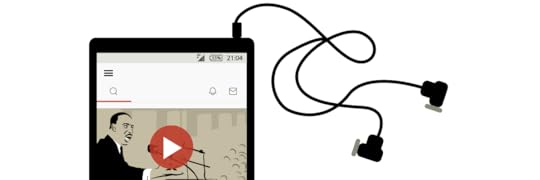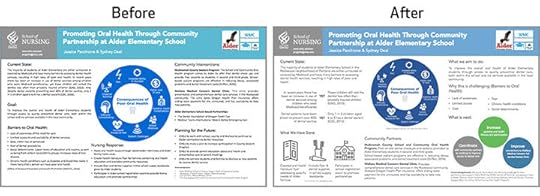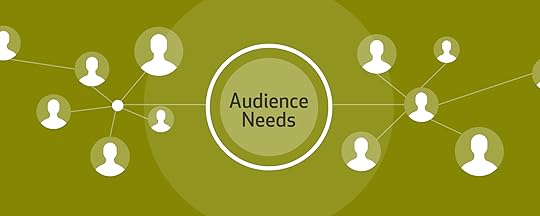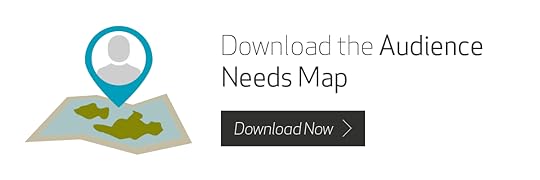Nancy Duarte's Blog, page 19
January 15, 2018
Communicate Like MLK and Change the World
This post was updated January 15, 2018.

Thanks to the proliferation and growth of social media and live video today, nearly everyone has a public platform that they can use to convey a message to a large audience. It’s possible to see more clearly than ever who can give a talk that moves people and changes minds.
But in a completely different category are speakers who pass the test of time, and one of them is Dr. Martin Luther King, Jr.

Today marks what would be Dr. King’s 89th birthday, and to celebrate the too-short life of this oratory genius, we thought we’d take a look at one of his most historic speeches: “I Have a Dream” – observing what makes it so spectacular and powerful. MLK’s “I Have a Dream” speech is not only literarily brilliant, its structure follows the presentation form perfectly, by traversing back and forth between what is and what could be, and ending by describing what the new bliss of equality looks like. In addition, MLK carefully chooses phrases and metaphors that resonate deeply with his audience.

If you’re struggling to create your next big presentation or even just crafting the message for your next staff meeting, take a few minutes to be inspired by the brilliance of one of America’s most beloved orators.
Dr. King’s “I Have a Dream” speech is one of the most famous in history – and when looking at it closely, it’s clear why. He crafted a speech that helped people see the potential ahead of them, and he employed tools that aided them in seeing what the future could be like if they were willing to take action. (Check out another post we published on the power of metaphors in “I Have a Dream” a few year back).
Thank You to Dr. King for standing up and speaking out to change the world.

While Dr. King was an undoubtedly naturally skilled orator whose talks changed the world, anyone can take a page out of his book and learn how to employ the same effective speaking techniques by keeping in mind the delivery and structural strategies Dr. King employed. When you deliver your next speech, you too can deliver a talk that stirs audiences and has a major impact.
Happy Birthday, Dr. King.
The post Communicate Like MLK and Change the World appeared first on Duarte.
January 11, 2018
How My Wife Created A Powerful Professional Poster

In 2017 I took 131 flights to lead 58 workshops. I spent close to 100 nights in hotels. Yes, it was exhausting, but also worth it because of the success stories I heard from clients. People don’t get smarter as the result of our workshops. They simply become better communicators. I see our workshop attendees use what they’ve learned to get promoted, close million dollar deals, and (a personal favorite) receive standing ovations at internal presentations.
My favorite success story of 2017, doesn’t come from one of our clients. It comes from my wife.

Jess graduated nursing school on December 8th. One of her final big assignments was a poster project: fit the contents of an entire research paper onto one poster.
The temptation with projects like this is to cram everything in. Write in bullet points. Play with the margins. Shrink the font size.
Of course, when you have a Duarte workshop facilitator as your husband well, perhaps he makes some tactful suggestions… We went the other way with this project. Jess ditched the bullets, represented ideas visually and made the most of white space—by leaving it white!
By applying visual principles to her poster, she was able to better communicate what her group was trying to say. Translation: people understood what they were talking about.
The result? Best-in-class poster. Her instructors asked her to present at a conference.

The best part is, the poster was created in PowerPoint. So even if you, dear reader, are not entering a poster contest, you will be able to apply this strategy to your slides. Here are the steps she followed that you can apply to your own work.
First, figure out the story you’re trying to tell. Most people skip this step. In this case, the story was that, while dental health services were being provided, they weren’t being fully taken advantage of. There were still several problems in the community. Jess and her partner had ideas on how to fix them.
Once you have figured out the story you’re trying to tell, then you can start editing accordingly. Example: on the “after” version, you’ll see in the top left there is text basically arranged in columns with the word “yet” in the middle. That’s to highlight the story mentioned above (they have access to dental services but weren’t taking full advantage of them).
Importantly because she understood her story, she was able to delete extraneous information – stuff that, while interesting, did not directly tie back to the story she was telling.
Once we had edited her information to tell a story, we wanted to make the story more digestible. In this case, that meant looking at all of her bullet points and splitting them into groups. Seven bullet points are too many; turning them into three groups was about right.
You know what’s even better than having three groups? Using visuals to represent those groups. Anytime you can use visuals instead of words, that is a huge win. People notice visuals before they notice words. People remember visuals better than they remember words. You’ll see where the bottom left goes from six bullet points to three icons.
Here’s the before and after:

Similarly, in the bottom right, she simplified the information into three groups: Coordinate, Increase, Improve. It would be nice to use pictures to represent those words visually. We couldn’t figure out how to do that*. Instead, we used simple diagrams and added color.
*If anyone knows a simple, self-explanatory visual to represent “coordinate” this is a good time to email mike@duarte.com or leave a note in the comments.
Once we re-organized everything, we took a step back to objectively answer an important question: if we were in the audience, would we want to look at this poster? It’s easy to answer “yes” to this because your poster will always make sense to you. Also because you just want the project to be over with. Objectively speaking, we realized there wasn’t enough white space. We re-sized the banner and Big Blue icon accordingly.
Here’s the finished poster compared to the original one
Let’s summarize so you can apply this to your work, whether it’s a poster, slides or something else:
Figure out the story you’re trying to tell. You need to be able to do that in a short sentence, two at most.
Write down everything you know about the topic, then remove anything that does not directly help tell the story you’re trying to tell.
Group your content together.
Use visuals to express those groups
Make sure there’s enough white space
Same information. More visuals. Less clutter.
How long did it take to fix all of this clutter? About an hour.
One hour. That’s it.
That’s all it took to go from “poster that would have been completely forgettable” to “poster that everyone stopped to look at.” You would think that everyone would be willing to spend that extra hour. Truth is, most people aren’t. But if you are…well, you might just be the next great Duarte success story. Do you have any success stories of your own? Tell us about them in the comments.
The post How My Wife Created A Powerful Professional Poster appeared first on Duarte.
January 8, 2018
7 Questions to Ask About Your Audience Before You Present
There’s a saying, “people don’t care what you know until they know how much you care.” That’s excellent life-advice, and it can also help you when you’re trying to write an audience-centric presentation. If you put the effort into considering your audience (a.k.a. “care”) you can give people information that truly matters to them. If [...] continue reading
The post 7 Questions to Ask About Your Audience Before You Present appeared first on Duarte.
January 4, 2018
How to Really Craft Audience-Centric Presentations
There’s a saying, “people don’t care what you know until they know how much you care.”
That’s excellent life-advice, and it can also help you when you’re trying to write an audience-centric presentation.
If you put the effort into considering your audience (a.k.a. “care”) you can give people information that truly matters to them. If it matters and it helps, they’ll be engaged. Basic human interaction principles, right?
It’s the same whether you’re talking to your partner, your boss, the seven people who came to your meeting, or the crowd you’re addressing at a conference.
There is one simple guiding principle that you should keep in mind as you’re creating your presentation. Your audience is not you. Once you accept this, you’ll find many new possible ways to position your content.
I find it helpful to print out this “Audience Needs Map” as I’m writing a presentation. It poses seven questions that I like to answer before I start writing and then glance at occasionally, especially if I’m stuck. These answers help shape and guide my content and presentation style. Better yet, these questions help me prepare for objections.
In this blog post, I’ll dig a little deeper and show you ways to think about how to answer each question.
1. What is Your Audience Like?
Statistics are a great place to begin exploring the make-up of your audience. Where did they go to school? What departments do they work in and at what levels? How old are they?
But, your audience isn’t going to be moved solely because they’re from the West Coast or work in HR; demographics are only part of the story. It’s important to get personal (like business-personal).
For example, imagine you’re a marketing executive tasked with presenting an advertising campaign to the data-driven accounting department. Instead of diving right into a flashy, cinematic pitch, you might want to sit down with someone on their team. Find out about their learning and communication styles, and how much they already know about you, your goals, and what you’re presenting on. You might find they’re skeptical of cinematic presentations, or they like to discuss ideas as they come up, or they’re sticklers for statistics.
That simple information can help you shape your content in a way that’s more likely to resonate with them.
Move away from what they do for work and acquaint yourself with who they are as people. Look for similarities, even if they’re unexpected!
Commonality fosters connection and a connection is the first step to engagement.
Click To Tweet
2. Why is Your Audience Here?
We’ve all been forced to go to meetings we’d rather not attend, and we’ve also all paid good money to listen to lectures on topics we care about. So, what’s the case with your audience? Are they mandatory attendees or willing participants?
When you understand the “why” behind their attendance—even if it’s simply to “appease their boss”—you can leverage that information. What do they think they are going to get out of this presentation? Why did they come to hear you? Did they have a choice?
A unique example of this is Virgin America’s in-flight safety video. The information presented is crucial to the safety of the passengers but can be tedious to explain and listen to. Recognizing the audience (passengers) are effectively captive to their seats, and they’ve seen similar presentations many times, the Virgin team realized they’d need to work harder to hold their attention. The safety video is peppered with humor, music, pop-culture references, and is downright entertaining! Seriously, it might be the first in-flight safety presentation you’ll want to watch more than once
When you recognize why the audience is present you can craft a presentation that speaks to their needs in a meaningful way.
Click To Tweet
3. What Keeps Your Audience Up At Night?
This question builds upon the first one, “what are they like?” but takes a more in-depth view of specific pain points.
For starters, do your due diligence – are you speaking to a group of millennials saddled with student loan debt? Or an executive team preparing to move across the country for a corporate relocation? What are the fears associated with those questions?
Even if you’re not addressing their specific issue, it’s essential to realize that presentations, like people, don’t exist in a vacuum. Take the time to understand the nuances of your audience; it can provide context as you develop the tone of your presentation.
4. How Can You Solve Your Audience’s Problem?
What’s in it for your audience? How are you going to make their lives better? How are you uniquely positioned to address their needs?
Provide meaningful, concrete insights and make sure you back them up. In Cheryl Hamilton and Bonnie Creel’s book, “Communicating for Success,” they remind would-be presenters, “no matter how much you already know about your subject, your audience will find your presentation more credible if you can back up your ideas and claims with materials from outside sources.”
The audience didn't come to see you, they came to learn from you. So give them what they came for.
Click To Tweet
5. How Can You Best Reach Your Audience?
What tools can you use to make sure your message is received?
Perhaps you’re not giving an in-person presentation but a virtual one. Presenting remotely comes with unique challenges. In these situations, the best way to reach them might be utilizing slide-docs to provide your key points ahead of time.
If you’re presenting in person, think about how to best set up the room and which materials to provide in advance or after the presentation.
People vary in how they receive information, once you’ve answered the preceding questions and understand how your audience best receives data you’ll be in a position to give the audience what they want, how they want it.
6. What Do You Want Your Audience to Do?
As you’re writing your presentation, consider actual best-case outcomes. Would your audience sign-up for follow-up program? Recommend your product to a friend? Buy your book? Would your boss sign-off on a larger budget?
Offering a “thirty-thousand-feet view” and painting a picture of “what could be” is a great start. However, as motivated as your audience might be, any momentum will quickly fade if they leave without tangible action items.
This is where the art of the call-to-action comes in.
It’s crucial to not overwhelm the crowd with too many action items, but ending your presentation with one or two tangible steps can be a powerful way to ensure forward motion.
7. How Might Your Audience Resist?
Change is hard, no matter the circumstances. So, in this case, the question shouldn’t be “how might they resist?” but rather, “how will you respond when they do?”
Organizational change is inherently difficult. Ask yourself, what will keep them from adopting your message and carrying out your call to action?
The challenges associated with change become especially pronounced in cases of a corporate merger. M&A news can be painful for everyone involved because often the two organizations were competitors with distinct brands, values, and cultures.
However, this resistance can also be an opportunity to leverage empathy and foster unity.
Last year, AT&T announced their intention to acquire Time Warner. Realizing the hurdles both inside (organizational culture, employee morale, etc.) and outside (bureaucratic and regulatory issues) investor Mark Cuban went straight for the emotional appeal. He claimed the merger would both increase consumer choice and allow the consumer’s the freedom to nostalgically enjoy TV the old-fashioned way, “on the couch, cold beverage in one hand and remote in the other.”
By leveraging the power of empathy, Cuban united various stakeholders around the common threads of freedom of choice and nostalgic appeal.
Another strategy that can be especially helpful in situations of resistance is to face the audience’s concerns head-on. If possible, take questions to allow the attendees to address lingering concerns. It can be extremely valuable to give them an opportunity to ask you to clarify anything that might not have been clear.
Ultimately the goal of these questions and this exercise is to figure out what your audience cares about and link it to your idea.
Your role as the mentor is to influence the hero (audience) at critical junctures of their lives. But, it’s tough to influence people you don’t know, which is why utilizing a tool like the “Audience Needs” map can be so helpful.
So take the time to get to honestly know the faces of the crowd! When your audience knows you care about who they are not just what they do or where they’re from, your message will not only be more impactful, but you might find yourself with some new friends along the way.
The post How to Really Craft Audience-Centric Presentations appeared first on Duarte.
December 27, 2017
Dreamforce 2017: Ushering in the 4th Industrial Revolution
“Every industrial revolution is defined by trailblazers. We’re in the Fourth Industrial Revolution, a wave of innovation and technology, radically transforming our economies, societies, and lives.” These words opened Salesforce’s Dreamforce 2017 as 171,000 live attendees and 10 million online viewers sat in awe taking in the video of trailblazers and the technologies they created [...] continue reading
The post Dreamforce 2017: Ushering in the 4th Industrial Revolution appeared first on Duarte.
Dreamforce 2017: Ushering in the 4th Industrial Revolution
“Every industrial revolution is defined by trailblazers. We’re in the Fourth Industrial Revolution, a wave of innovation and technology, radically transforming our economies, societies, and lives.”
These words opened Salesforce’s Dreamforce 2017 as 171,000 live attendees and 10 million online viewers sat in awe taking in the video of trailblazers and the technologies they created that shaped the world forever. Dreamforce is a home for trailblazers, and Salesforce CEO and Chairman, Marc Benioff, welcomed them back in his opening keynote.
Benioff set out to persuade the audience that the Fourth Industrial Revolution will be where artificial intelligence, robotics, and the Internet of Things (IoT) transform the customer experience. You can already see this change every day: shopping via voice command, autonomous cars, and smart devices that keep you connected and always-on.
In the Fourth Industrial Revolution, artificial intelligence will help businesses connect to their customers in a whole new way. Benioff sought to instill in the audience, that they, the “Trailblazers” were the drivers behind this movement.
Salesforce users from 21st Century Fox, T-Mobile, adidas, and more took center stage during Benioff’s keynote—highlighting Salesforce’s customer-centric emphasis and these companies’ key role in the Fourth Industrial Revolution.
The Fourth Industrial Revolution wasn’t the only thing front and center in Benioff’s keynote. Salesforce was nominated by the Human Rights Campaign as one of the Best Places to Work 2017 for LGBTQ Equality as well as Fortune’s #1 Workplace for Giving Back. Salesforce sees this as being important because while the Fourth Industrial Revolution is going to bring progress, it also increases the chances that there may be more inequality in this world, and that is something we all as individuals and as businesses need to be mindful to address.
Last year Salesforce spent $3 million to close the gender pay gap and this year they spent another $3 million to raise pay for 11% of employees, proving that Salesforce is a true trailblazer in setting the standard for equality in the workplace.
Benioff, who sees Dreamforce as a big family reunion, always brings things back to the idea of Ohana — the Hawaiian word for “family,” which includes Salesforce’s employees, customers, partners, and community.
This was Duarte’s seventh year working with Salesforce on Dreamforce, and we certainly feel like family. The experience of working on this always incredible event, which is in a constant state of reiteration and change, is nothing short of rewarding.
Benioff brought to light how The Fourth Industrial Revolution is bringing unprecedented change to our lives, but also unprecedented opportunity for growth and deeper customer connections. As Salesforce scales and prepares for the future, this year’s Dreamforce encouraged attendees to be on the lookout for ways that they, too, can blaze a trailblazer.
Duarte is proud to have worked with the Salesforce team on executing yet another amazing Dreamforce keynote. Now, we blaze a trail onwards towards Dreamforce 2018…
The post Dreamforce 2017: Ushering in the 4th Industrial Revolution appeared first on Duarte.
December 4, 2017
How Communication Training Leads to Superstar Teams
I’ve spent much of my life working in sales. That’s meant lots of time flying or driving on the way to meet a client. Typically, we’d meet in conference rooms; if things went well, we’d do dinner. No matter what, we spent time face-to-face. If I made a meh first impression (it happens), I’d sometimes get [...] continue reading
The post How Communication Training Leads to Superstar Teams appeared first on Duarte.
November 27, 2017
How Communication Training Leads to Superstar Teams
 I’ve spent much of my life working in sales. That’s meant lots of time flying or driving on the way to meet a client. Typically, we’d meet in conference rooms; if things went well, we’d do dinner. No matter what, we spent time face-to-face. If I made a meh first impression (it happens), I’d sometimes get the chance to make a better second or third impression.
I’ve spent much of my life working in sales. That’s meant lots of time flying or driving on the way to meet a client. Typically, we’d meet in conference rooms; if things went well, we’d do dinner. No matter what, we spent time face-to-face. If I made a meh first impression (it happens), I’d sometimes get the chance to make a better second or third impression.
In today’s digital world, however, it’s rare that I fly or drive to meet clients in-person. In fact, most of our communication happens via digital platforms, like email, text, conference calls, and video conferences. This doesn’t just apply to clients or prospects. Given the distributed nature of our teams, I’m more likely to email my colleagues, send them a slidedoc, and follow up with a conference call where we can really talk. And I’m not alone:
2.4 million emails are sent every second (source)
781 billion text messages are sent per month (source)
66% of older managers prioritize in-person communication rather than remote, but millennials prefer digital communication (source)
The rapid growth of tech has made transmitting information easier and faster than ever before. But the unexpected consequence is that in-person communication is both more rare and higher stakes. That’s one of the many reasons organizations should put be putting a premium on communication training.
Communication skills training can teach people to craft and deliver better presentations. At the core of both those skills is the art of connecting with people, which isn’t something we all do naturally. That ability to relate and resonate can make or break your career. Managers can better motivate employees. Sales and account teams can read the room and determine how to persuasively present your products and services. Why? Because they know to think about who they’re talking to and what matters to that audience. Let’s dive into how communication training can help a variety of your teams.
Communication Training Helps Your Analytical Types Articulate Ingenious Ideas
I spent years working with customer experience analysts who were so good at analyzing numbers they could get lost in their own data. Their analysis showed how they could improve the customer experience, but they often forgot that those numbers (on the surface) meant very little to anyone else.
To help them communicate their brilliant findings to company leaders, we’d work together to turn those numbers into meaningful insights. Then, we’d use those insights to tell a story about the impact on one individual customer. This type of story, about one person’s experience, moved people’s minds and hearts – and inspired action.
Your team of analysts is probably stacked with numerical geniuses who can slice and dice data.
But they might not know that data alone doesn’t inspire action, stories do.
If those analysts aren’t trained to communicate what that data means to your audience, your company could miss out on an incredible opportunity.
Communication Training Helps Your Sales People Sell
I recently talked to a company that had decided the best way to build their reputation was to hit the speaker circuit.
But, just because someone can design product, doesn’t mean they can sell it.
Great ideas can be the foundation of companies, but a company can’t grow if nobody understands what it does. Building common ground with an audience, delivering facts with a story structure, and presenting confidently will arm your people with the tools to explain how your solution works and why people should care.
Communication Training Helps Your Execs Navigate A Crisis
An organizational crisis can be extremely trying for a business. Clear, empathetic communication is the most critical tool to guide your team through it and help them emerge stronger.
In our most recent book, Illuminate, there’s a great example of a company that was able to steer away from impending disaster when execs learned how to better communicate.
During the early 1990s, IBM began to slip behind its competitors and bankruptcy loomed. Facing a crisis, the company hired their first new CEO from outside its ranks – Louis Gerstner Jr. He faced not only a failing company, but also a team of resistant colleagues.
Gerstner knew he had to create an internal shift. He first went on a “listening tour,” making sure all employees felt heard. Then, he shaped a communication strategy based on what he learned. Finally, Gerstner went all in with “Operation: Bear Hug.” Execs and managers learned to directly address customer and employee dissatisfaction and recap those conversations in a memo. Then, they bear-hugged their colleagues.
It may sound a little silly, but this change in communication strategy created a drastic shift in IBM’s culture. It helped reinvigorate the company and direct it toward becoming the market-driven innovator it is today.

Communication Training Helps Managers Get The Most Out Of Their Team
Poor communication is at the root of many in-office productivity issues. In fact, studies have shown that 28% of people that believe poor communication is the primary reason professionals fail to deliver projects on time. Also, in a survey by HR Magazine, 46% of employees said that they often receive unclear directions from bosses and managers – at least 3 times per day.
That’s a lot of miscommunication.
Poor communication doesn’t just impact productivity – it also impacts morale. Studies show that companies with effective communications practices have turnover rates 50% lower than their industry average – which means that if your company has poor communication practices, it may have a hard time with keeping employees happy and retaining them.
Train your managers to be fantastic communicators and they’ll lead a happy and productive team.
When Starbucks was struggling in 2008, CEO Howard Schultz knew that he had to create a shift within Starbucks retail locations in order to rescue the company. He decided to host a conference in New Orleans for thousands of Starbucks store managers.
During the conference, Schultz spoke frankly with the managers about the company’s financial woes. He then had the managers help undertake re-building and charitable projects. He gave out t-shirts with positive, empathetic messages on them – like “Onward” and “Believe in the Power of 10,000.” He also held interactive exercises, teaching managers to use empathy, compassion, and positivity when running their teams and stores.
By the end of the conference, he asked each manager to sign his or her name on a wall of commitment – committing to running their retail location with the new empathetic communication skills they acquired. After the conference, Starbucks as a whole experienced a cultural shift – and the company climbed back to profit.

The Power of Communication Training
I recently had the pleasure of attending a client event at Irvine Company. This company understands the importance of communication training, and they have embedded presentation training, or what they call Executive Presence, into their management training program. Individuals are nominated by their boss to attend an extensive 8-month program, and Duarte is fortunate enough to be a part of that program. Each of the team members learns the core concepts in our VisualStory® and Captivate workshops. At the end of the program, they present what they took away from the training to their boss, peers, and senior executives. This last event literally shows the importance and power of effective communication and the presentations I saw were stellar.
The post How Communication Training Leads to Superstar Teams appeared first on Duarte.
November 17, 2017
A Case Story: Teradata | The Edge of Next
Does the future live only in the greatest minds? That is the question posed at the opening of the Teradata PARTNERS Conference 2017, followed by cinematic and awe-inspiring images of technological advancements over times like Stonehenge, the Egyptian pyramids, and the Great Wall of China. Audience members were transported through the ages as thunder cracked, [...] continue reading
The post A Case Story: Teradata | The Edge of Next appeared first on Duarte.
November 14, 2017
A Case Story: Teradata | The Edge of Next
Does the future live only in the greatest minds? That is the question posed at the opening of the Teradata PARTNERS Conference 2017, followed by cinematic and awe-inspiring images of technological advancements over times like Stonehenge, the Egyptian pyramids, and the Great Wall of China. Audience members were transported through the ages as thunder cracked, lightning flashed, and interpretive dancers took the stage, only to be taken in flight and suspended in mid-air.
If you simply think “hardware” or “data warehouse” when you think of Teradata, you need to think again. During the Teradata PARTNERS Conference in Anaheim, California on October 22-26, 2017, Teradata EVP and Chief Product Officer Oliver Ratzesberger unveiled how Teradata plans to succeed in “The Edge of Next.” With close to 3,000 of the brightest and most innovative minds in data and analytics in attendance from 500+ companies in 45+ countries, Teradata showcased significant enhancements to its Teradata Everywhere strategy, Teradata IntelliSphere™.
The event used cutting edge visual techniques as Ratzesberger’s keynote was displayed across seven different screens simultaneously, highlighting the four benefits of Teradata Everywhere…
#1 Analyze anything: Enables analytic users throughout the organization to use their preferred analytic tools and engines across data sources, at scale
#2 Deploy anywhere: Provides analytic processing across flexible deployment options, including the Teradata Cloud and public clouds, as well as on-premises on Teradata hardware or commodity hardware
#3 Buy anyway: Empowers companies to purchase software in more accommodating ways based on specific use cases through simplified pricing bundles, subscription-based licenses, and as-a-service options
#4 Move anytime: Future-proofs buying decisions by taking advantage of our software license portability that provides flexibility to run analytics across deployment options
Ratzesberger’s book, The Sentient Enterprise: The Evolution of Business Decision Making further addresses the data concerns of today’s enterprise, and explains a way to help enterprises achieve the success they seek.
Through visually captivating scenes paired with a compelling narrative, Teradata portrayed how its products, supported by an independent consultative approach, can be used to actually use your data for better business outcomes.
Duarte helped Teradata turn this idea into a visual story so that they could go above the functionality of the product and explain what “Teradata Everywhere” means.
The animated model that moved across each of the seven screens visually guided attendees through each of the product components, while instilling in the audience’s mind that Teradata has their fingertip on the future of artificial intelligence and automation.
Attendees left the event knowing that Teradata is truly a partner for helping companies use their data to make decisions, with an understanding of today’s best practices and a clear vision for tomorrow.
Duarte is proud to have worked with Teradata on such a visually groundbreaking project, helping them turn a complex idea into an easily digestible and motivating visual storyline.
The post A Case Story: Teradata | The Edge of Next appeared first on Duarte.

















